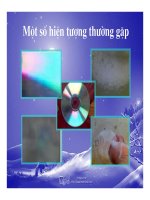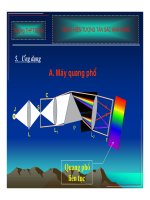bài giảng vật lý bằng tiếng anh continuity
Bạn đang xem bản rút gọn của tài liệu. Xem và tải ngay bản đầy đủ của tài liệu tại đây (396.02 KB, 26 trang )
CONTINUITY
CONTINUITY
We noticed in Section 1.4 that the limit of
a function as x approaches a can often be
found simply by calculating the value of
the function at a.
Functions with this property are called ‘‘continuous
at a.’’
We will See that the mathematical definition of
continuity corresponds closely with the meaning of
the word continuity in everyday language.
1.5 P2
Definition 1
A function f is continuous at a number a
if:
lim f ( x) = f ( a)
x→a
Notice that Definition 1 implicitly requires
three
things
if
f
is
continuous
at
a:
lim f ( x)
x →a
f(a) is defined—that is, a is in the domain of f
lim f ( x) = f ( a)
x→a
exists.
1.5 P3
CONTINUITY
The definition states that f is continuous at
a if f(x) approaches f(a) as x approaches a.
Thus, a continuous function f
has the property that a small
change in x produces only
a small change in f(x).
In fact, the change in f(x)
can be kept as small as we
please by keeping the
change in x sufficiently small.
1.5 P4
CONTINUITY
If f is defined near a—that is, f is defined on
an open interval containing a, except perhaps
at a—we say that f is discontinuous at a (or f
has a discontinuity at a) if f is not continuous
at a.
Physical phenomena are usually continuous.
For instance, the displacement or velocity
of a vehicle varies continuously with time,
as does a person’s height.
1.5 P5
CONTINUITY
However, discontinuities do occur in such
situations as electric currents.
See Example 6 in Section 1.3, where the Heaviside
function is discontinuous at 0 because
lim H (t )
t →0
does not exist.
Geometrically, you can think of a function that
is continuous at every number in an interval as
a function whose graph has no break in it.
The graph can be drawn without removing your pen from
the paper.
1.5 P6
Example 1
Figure 2 shows the graph of a function f.
At which numbers is f discontinuous?
Why?
1.5 P7
Example 1 SOLUTION
It looks as if there is a discontinuity when
a = 1 because the graph has a break there.
The official reason that
f is discontinuous at 1
is that f(1) is not defined.
1.5 P8
Example 1 SOLUTION
The graph also has a break when a = 3.
However, the reason for the discontinuity
is different.
Here, f(3) is defined,
lim f ( x)
but x →3
does not exist
(because the left and
right limits are different).
So, f is discontinuous
at 3.
1.5 P9
Example 1 SOLUTION
What about a = 5?
f ( x) exists (because
Here, f(5) is defined and lim
x →5
the left and right limits are the same).
f ( x) ≠ f (5)
However, lim
x →5
So, f is discontinuous
at 5.
1.5 P10
CONTINUITY
Now, let’s see how to detect
discontinuities when a function is defined
by a formula.
1.5 P11
Example 2
Where are each of the following functions
discontinuous?
x2 − x − 2
(a) f ( x) =
x−2
1
if x ≠ 0
2
f ( x) = x
(b)
1
if x = 0
x2 − x − 2
if x ≠ 2
(c) f ( x) = x − 2
1
if x = 2
(d) f ( x) x
1.5 P12
Example 2(a) SOLUTION
Notice that f(2) is not defined. So, f is
discontinuous at 2.
Later, we’ll see why f is continuous at all other
numbers.
1.5 P13
Example 2(b) SOLUTION
(b)Here, f(0) = 1 is defined.
1
lim f ( x) = lim 2
x →0
x →0 x
does not exist.
See Example 8 in Section 1.3.
So, f is discontinuous at 0.
1.5 P14
Example 2(c) SOLUTION
Here, f(2) = 1 is defined and
x2 − x − 2
( x − 2)( x + 1)
lim f ( x) = lim
= lim
x →2
x→2
x→2
x−2
x−2
= lim( x + 1) = 3
x→2
exists. But
lim f ( x) ≠ f (2)
x→2
So, f is not continuous at 2.
1.5 P15
Example 2(d) SOLUTION
f ( x) = § x ¨
The greatest integer function
has discontinuities at all the integers. This
lim § x ¨
is because
does not exist if n is an
x® n
integer.
See Example 8 in Section 1.4.
1.5 P16
CONTINUITY
Figure 3 shows the graphs of the functions
in Example 2.
In each case, the graph can’t be drawn without
lifting the pen from the paper—because a hole or
break or jump occurs in the graph.
1.5 P17
CONTINUITY
The kind of discontinuity illustrated in
parts (a) and (c) is called removable.
We could remove the discontinuity by redefining f
at just the single number 2.
The function g ( x) = x + 1 is continuous.
1.5 P18
CONTINUITY
The discontinuity in part (b) is called an
infinite discontinuity.
1.5 P19
CONTINUITY
The discontinuities in part (d) are called
jump discontinuities.
The function ‘‘jumps’’ from one value to another.
1.5 P20
Definition 2
A function f is continuous from the right
at a number a if
lim+ f ( x) = f (a )
x →a
and f is continuous from the left at a if
lim− f ( x) = f (a)
x→a
1.5 P21
Example 3
f ( x) = x
At each integer n, the function
is continuous from the right but
discontinuous from the left because
lim+ f ( x) = lim+ § x ¨ = n = f ( n)
x®n
butlim
-
x® n
x® n
f ( x) = lim- § x ¨ = n - 1 ¹ f ( n)
x® n
1.5 P22
Definition 3
A function f is continuous on an interval
if it is continuous at every number in the
interval.
(If f is defined only on one side of an
endpoint of the interval, we understand
‘‘continuous at the endpoint’’ to mean
‘‘continuous from the right’ or ‘continuous
from the left.’’)
1.5 P23
Example 4
f ( x) = 1 − 1 − x
Show that the function
is continuous on the interval [– 1, 1].
SOLUTION
2
If –1 < a < 1, then using the Limit Laws, we have:
lim f ( x) = lim(1 − 1 − x 2 )
x →a
x→a
=1 − lim 1 − x 2
x →a
(by Laws 2 and 7)
=1 − lim(1 − x 2 ) (by Law 11)
x →a
= 1 − 1 − a2
= f (a )
(by Laws 2, 7, and 9)
1.5 P24
Example 4 SOLUTION
Thus, by Definition 1, f is continuous at a if
– 1 < a < 1.
Similar calculations show that
lim+ f ( x) = 1 = f ( −1) and lim− f ( x) = 1 = f (1)
x →−1
x →1
So, f is continuous from the right at – 1 and
continuous from the left at 1.
Therefore, according to Definition 3, f is continuous
on [– 1, 1].
1.5 P25









